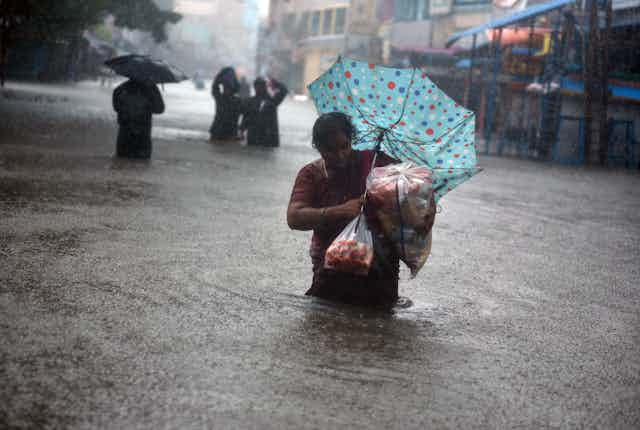November 2021 was a devastating month for flooding in the city of Chennai, the capital of Tamil Nadu in southern India. With 1,000mm of rainfall in just four weeks, these were the worst rains since the devastating floods of 2015 when it poured for 22 out of 30 days in December, setting a record of 1,049mm.
Then, as now, the flooding in Chennai was described as a man-made disaster, despite occurring during a storm called Cyclone Nivar. On both occasions, death, disruption and destruction was the result. India has faced more than 300 weather events in the last two decades, resulting in over 79,000 deaths.
Tamil Nadu has long been known for its susceptibility to a long list of natural disasters: cyclones, storm surges, coastal flooding, torrential rainfall, earthquakes and tsunamis. India accounts for 24% of all disasters in Asia and Chennai ranks seventh in the list of India’s most vulnerable districts to extreme flooding and cyclones.
The southern state’s 1,076km of coastline makes up more than 13% of the total Indian coastline, bordered by the Bay of Bengal in the east, the Indian Ocean in the south and the Arabian Sea in the west.
Cyclones need a lot of heat (at least 26°C) to form, and warm tropical sea beds provide this energy. The Bay of Bengal has a deep layer of warm water, which fuels the rapid formation of cyclones that gather force within a short period of time.
Since the catastrophic 2004 Boxing Day tsunami which killed 10,000 people in Tamil Nadu, there have been 14 cyclones and regular flooding in this area. Yet the preparation and response to these extreme events have been woefully inadequate over the last 15 years.
Why has nothing changed?
The Indian Meteorological Department issued a red alert warning on November 12 2021. But 48 hours later Chennai had once again ground to a standstill due to heavy rainfall triggered by the north-east monsoon season which occurs between October-December annually.
Seventeen deaths were recorded, and power outages, submerged dams and underpasses hampered movement around the city, including rescue operations by the National Disaster Risk Force (NDRF).
As Tamil Nadu’s tech-hub “smart city”, Chennai has attracted newcomers with the prospect of good jobs, housing and amenities, swelling its population to just over 11m people. This has put even more pressure on existing infrastructure and services.
Despite the continuous development and increasing population, nothing in the city’s disaster response has changed over the last 16 years, even after the devastating 2015 floods. Officials failed to take preventive measures and released dam water without announcement, over-filling the Chembarambakkam reservoir flooding the nearby areas. The city’s densely packed housing has only made preparation for any future extreme weather events more difficult.
Gridlocked systems
Most of Chennai’s problems revolve around inadequate and poorly managed infrastructure, resulting in leaks, blocked drains and over-burdened sewage systems – problems that have existed in Chennai for decades. Bad planning is also an issue in the city, where the state government has allowed building and development on marshlands and wetlands which would normally have soaked up floodwater.
The Cooum, which flows through the city, has slowly become a highly polluted, toxic river full of sewage. During the 2015 Chennai floods, it quickly became an open sewer as the city’s drains overflowed and the water submerged sewage systems.
One of the greatest problems the city faces is plastic pollution. Around 3.4 million tonnes of plastic waste are generated by India each year. Chennai ranks second in the country for plastic waste, producing 429 tonnes a day. The plastic clogs up drains and sewers so that during heavy rainfall floodwater has nowhere to go, resulting in waterlogged streets.
Failure of policies and inadequate infrastructure coupled with excessive bureaucracy and inaction mean that every time there are heavy rains or storms, Chennai’s citizens face disruption, displacement and tragedy as they did in November. It is essential that the city significantly reduces its plastic pollution, invests in proper floodwater drainage and continually re-assesses the changing risks and vulnerabilities to future flood scenarios.
Making the right decisions and implementing them may not be a straightforward process in a country like India because of widespread poverty, lack of planning, coordination and proper channelling of funding. Perhaps cities like Chennai need to adopt alternative approaches such as community-based flood management programmes.
This would encourage communities to take responsibility and action, empowering the very people whom the flooding affects most. It would also help to dispel the dangerous sense of inevitability that pervades the city about flooding.
There are specific reasons Chennai floods so easily, but they can be addressed. Awareness of how plastic pollution contributes to the problem and what can be done about it at a local level would be a good place to start.

